BSBRSK501 - Developing a Risk Management Plan for OSY Business
VerifiedAdded on 2023/06/18
|6
|2964
|406
Case Study
AI Summary
This case study presents a risk management plan developed for Office Supplies to You (OSY), a small business experiencing growth in the competitive stationery retail industry. The plan addresses declining industry revenue due to increasing online competition and the shift towards a digital economy. The solution outlines strategies for reviewing organizational processes, procedures, and requirements in accordance with current risk management standards, including risk identification, assessment, control, and treatment. It emphasizes the importance of stakeholder inclusion in developing the risk assessment plan and identifies internal and external stakeholders. Various research methods, such as decision tree analysis, are suggested for risk management activities. The plan also highlights critical success factors to ensure compliance with legislation and requirements within OSY's procedures, documented through an identification document and risk register.
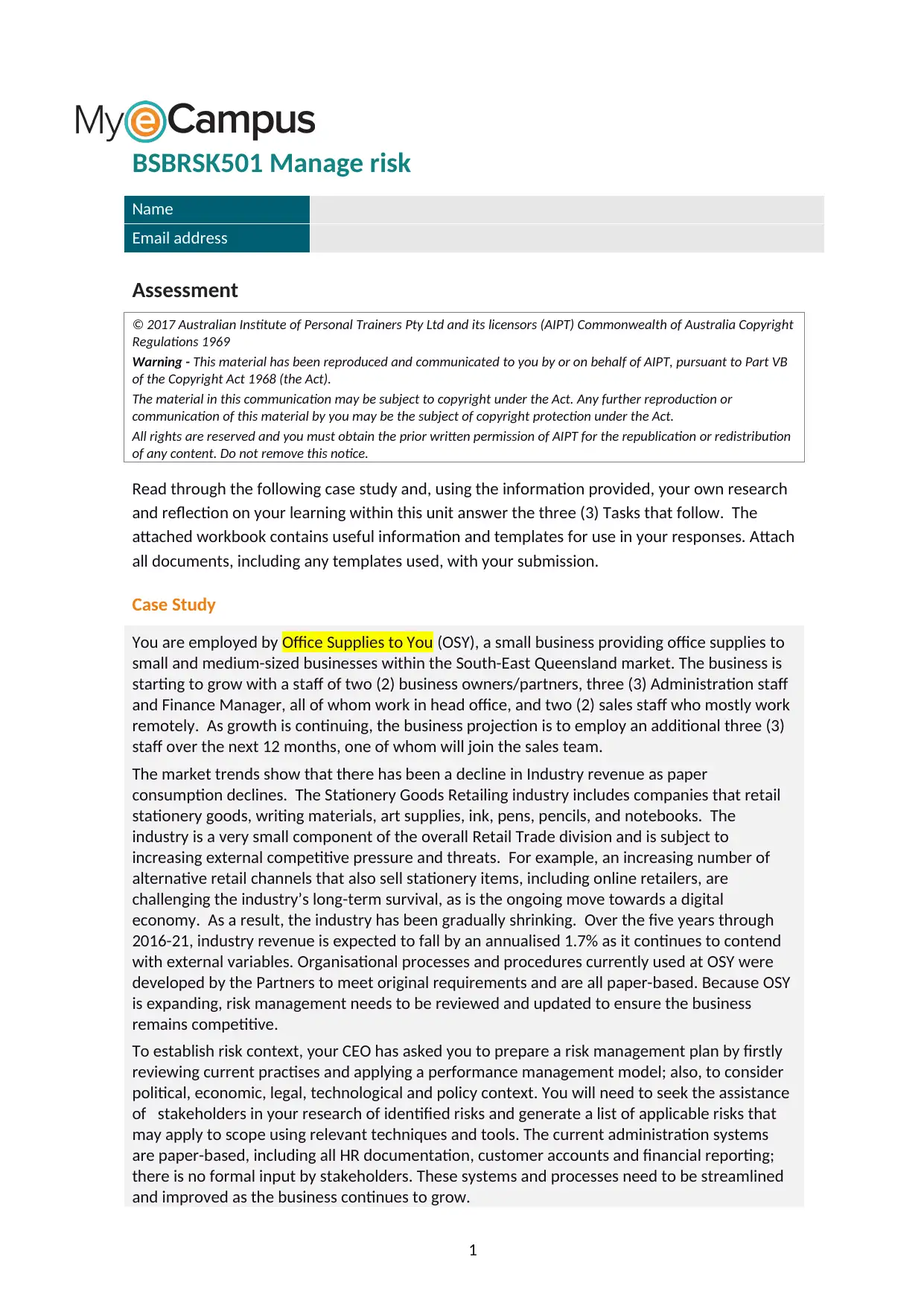
BSBRSK501 Manage risk
Name
Email address
Assessment
© 2017 Australian Institute of Personal Trainers Pty Ltd and its licensors (AIPT) Commonwealth of Australia Copyright
Regulations 1969
Warning - This material has been reproduced and communicated to you by or on behalf of AIPT, pursuant to Part VB
of the Copyright Act 1968 (the Act).
The material in this communication may be subject to copyright under the Act. Any further reproduction or
communication of this material by you may be the subject of copyright protection under the Act.
All rights are reserved and you must obtain the prior written permission of AIPT for the republication or redistribution
of any content. Do not remove this notice.
Read through the following case study and, using the information provided, your own research
and reflection on your learning within this unit answer the three (3) Tasks that follow. The
attached workbook contains useful information and templates for use in your responses. Attach
all documents, including any templates used, with your submission.
Case Study
You are employed by Office Supplies to You (OSY), a small business providing office supplies to
small and medium-sized businesses within the South-East Queensland market. The business is
starting to grow with a staff of two (2) business owners/partners, three (3) Administration staff
and Finance Manager, all of whom work in head office, and two (2) sales staff who mostly work
remotely. As growth is continuing, the business projection is to employ an additional three (3)
staff over the next 12 months, one of whom will join the sales team.
The market trends show that there has been a decline in Industry revenue as paper
consumption declines. The Stationery Goods Retailing industry includes companies that retail
stationery goods, writing materials, art supplies, ink, pens, pencils, and notebooks. The
industry is a very small component of the overall Retail Trade division and is subject to
increasing external competitive pressure and threats. For example, an increasing number of
alternative retail channels that also sell stationery items, including online retailers, are
challenging the industry’s long-term survival, as is the ongoing move towards a digital
economy. As a result, the industry has been gradually shrinking. Over the five years through
2016-21, industry revenue is expected to fall by an annualised 1.7% as it continues to contend
with external variables. Organisational processes and procedures currently used at OSY were
developed by the Partners to meet original requirements and are all paper-based. Because OSY
is expanding, risk management needs to be reviewed and updated to ensure the business
remains competitive.
To establish risk context, your CEO has asked you to prepare a risk management plan by firstly
reviewing current practises and applying a performance management model; also, to consider
political, economic, legal, technological and policy context. You will need to seek the assistance
of stakeholders in your research of identified risks and generate a list of applicable risks that
may apply to scope using relevant techniques and tools. The current administration systems
are paper-based, including all HR documentation, customer accounts and financial reporting;
there is no formal input by stakeholders. These systems and processes need to be streamlined
and improved as the business continues to grow.
1
Name
Email address
Assessment
© 2017 Australian Institute of Personal Trainers Pty Ltd and its licensors (AIPT) Commonwealth of Australia Copyright
Regulations 1969
Warning - This material has been reproduced and communicated to you by or on behalf of AIPT, pursuant to Part VB
of the Copyright Act 1968 (the Act).
The material in this communication may be subject to copyright under the Act. Any further reproduction or
communication of this material by you may be the subject of copyright protection under the Act.
All rights are reserved and you must obtain the prior written permission of AIPT for the republication or redistribution
of any content. Do not remove this notice.
Read through the following case study and, using the information provided, your own research
and reflection on your learning within this unit answer the three (3) Tasks that follow. The
attached workbook contains useful information and templates for use in your responses. Attach
all documents, including any templates used, with your submission.
Case Study
You are employed by Office Supplies to You (OSY), a small business providing office supplies to
small and medium-sized businesses within the South-East Queensland market. The business is
starting to grow with a staff of two (2) business owners/partners, three (3) Administration staff
and Finance Manager, all of whom work in head office, and two (2) sales staff who mostly work
remotely. As growth is continuing, the business projection is to employ an additional three (3)
staff over the next 12 months, one of whom will join the sales team.
The market trends show that there has been a decline in Industry revenue as paper
consumption declines. The Stationery Goods Retailing industry includes companies that retail
stationery goods, writing materials, art supplies, ink, pens, pencils, and notebooks. The
industry is a very small component of the overall Retail Trade division and is subject to
increasing external competitive pressure and threats. For example, an increasing number of
alternative retail channels that also sell stationery items, including online retailers, are
challenging the industry’s long-term survival, as is the ongoing move towards a digital
economy. As a result, the industry has been gradually shrinking. Over the five years through
2016-21, industry revenue is expected to fall by an annualised 1.7% as it continues to contend
with external variables. Organisational processes and procedures currently used at OSY were
developed by the Partners to meet original requirements and are all paper-based. Because OSY
is expanding, risk management needs to be reviewed and updated to ensure the business
remains competitive.
To establish risk context, your CEO has asked you to prepare a risk management plan by firstly
reviewing current practises and applying a performance management model; also, to consider
political, economic, legal, technological and policy context. You will need to seek the assistance
of stakeholders in your research of identified risks and generate a list of applicable risks that
may apply to scope using relevant techniques and tools. The current administration systems
are paper-based, including all HR documentation, customer accounts and financial reporting;
there is no formal input by stakeholders. These systems and processes need to be streamlined
and improved as the business continues to grow.
1
Paraphrase This Document
Need a fresh take? Get an instant paraphrase of this document with our AI Paraphraser
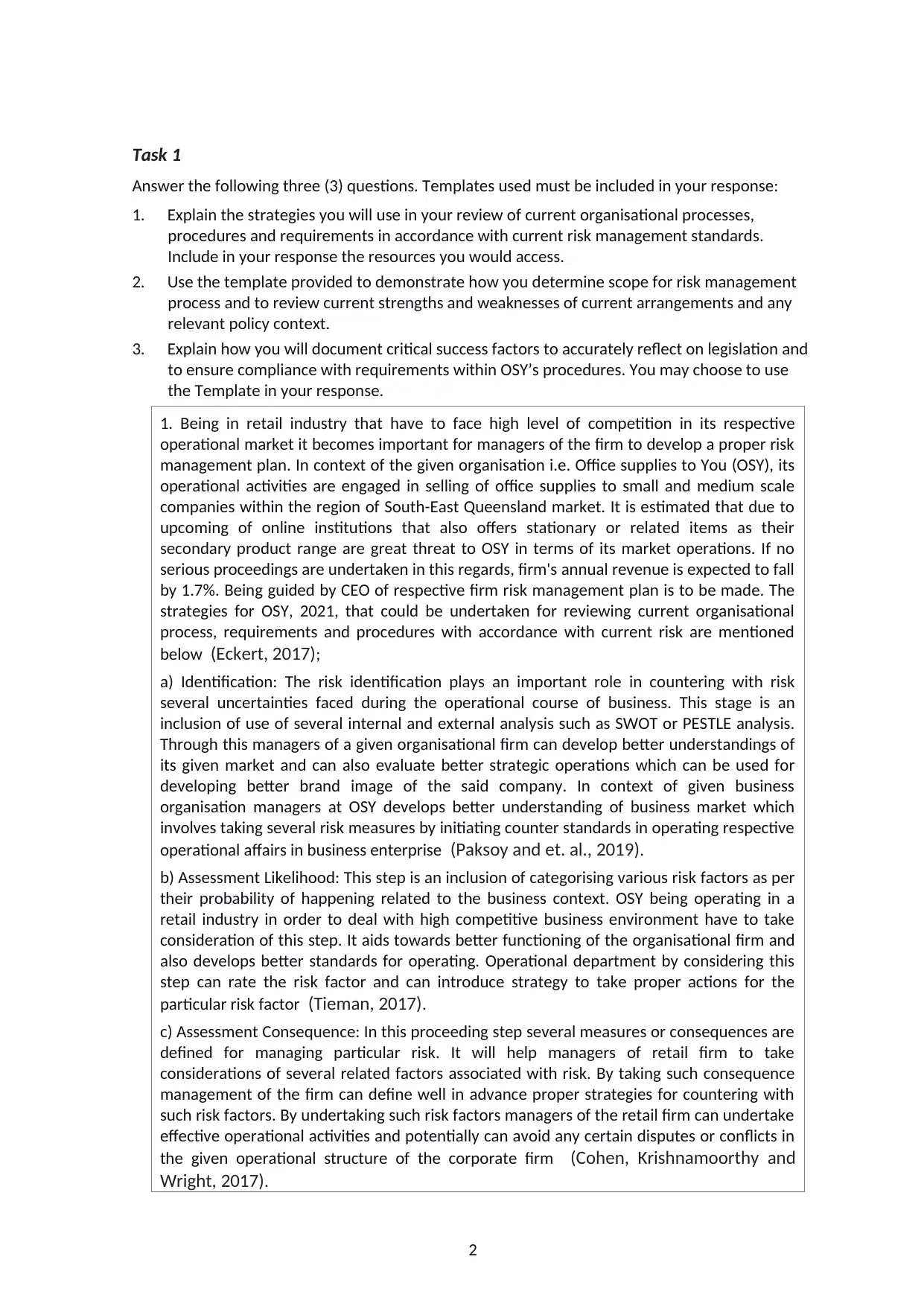
Task 1
Answer the following three (3) questions. Templates used must be included in your response:
1. Explain the strategies you will use in your review of current organisational processes,
procedures and requirements in accordance with current risk management standards.
Include in your response the resources you would access.
2. Use the template provided to demonstrate how you determine scope for risk management
process and to review current strengths and weaknesses of current arrangements and any
relevant policy context.
3. Explain how you will document critical success factors to accurately reflect on legislation and
to ensure compliance with requirements within OSY’s procedures. You may choose to use
the Template in your response.
1. Being in retail industry that have to face high level of competition in its respective
operational market it becomes important for managers of the firm to develop a proper risk
management plan. In context of the given organisation i.e. Office supplies to You (OSY), its
operational activities are engaged in selling of office supplies to small and medium scale
companies within the region of South-East Queensland market. It is estimated that due to
upcoming of online institutions that also offers stationary or related items as their
secondary product range are great threat to OSY in terms of its market operations. If no
serious proceedings are undertaken in this regards, firm's annual revenue is expected to fall
by 1.7%. Being guided by CEO of respective firm risk management plan is to be made. The
strategies for OSY, 2021, that could be undertaken for reviewing current organisational
process, requirements and procedures with accordance with current risk are mentioned
below (Eckert, 2017);
a) Identification: The risk identification plays an important role in countering with risk
several uncertainties faced during the operational course of business. This stage is an
inclusion of use of several internal and external analysis such as SWOT or PESTLE analysis.
Through this managers of a given organisational firm can develop better understandings of
its given market and can also evaluate better strategic operations which can be used for
developing better brand image of the said company. In context of given business
organisation managers at OSY develops better understanding of business market which
involves taking several risk measures by initiating counter standards in operating respective
operational affairs in business enterprise (Paksoy and et. al., 2019).
b) Assessment Likelihood: This step is an inclusion of categorising various risk factors as per
their probability of happening related to the business context. OSY being operating in a
retail industry in order to deal with high competitive business environment have to take
consideration of this step. It aids towards better functioning of the organisational firm and
also develops better standards for operating. Operational department by considering this
step can rate the risk factor and can introduce strategy to take proper actions for the
particular risk factor (Tieman, 2017).
c) Assessment Consequence: In this proceeding step several measures or consequences are
defined for managing particular risk. It will help managers of retail firm to take
considerations of several related factors associated with risk. By taking such consequence
management of the firm can define well in advance proper strategies for countering with
such risk factors. By undertaking such risk factors managers of the retail firm can undertake
effective operational activities and potentially can avoid any certain disputes or conflicts in
the given operational structure of the corporate firm (Cohen, Krishnamoorthy and
Wright, 2017).
2
Answer the following three (3) questions. Templates used must be included in your response:
1. Explain the strategies you will use in your review of current organisational processes,
procedures and requirements in accordance with current risk management standards.
Include in your response the resources you would access.
2. Use the template provided to demonstrate how you determine scope for risk management
process and to review current strengths and weaknesses of current arrangements and any
relevant policy context.
3. Explain how you will document critical success factors to accurately reflect on legislation and
to ensure compliance with requirements within OSY’s procedures. You may choose to use
the Template in your response.
1. Being in retail industry that have to face high level of competition in its respective
operational market it becomes important for managers of the firm to develop a proper risk
management plan. In context of the given organisation i.e. Office supplies to You (OSY), its
operational activities are engaged in selling of office supplies to small and medium scale
companies within the region of South-East Queensland market. It is estimated that due to
upcoming of online institutions that also offers stationary or related items as their
secondary product range are great threat to OSY in terms of its market operations. If no
serious proceedings are undertaken in this regards, firm's annual revenue is expected to fall
by 1.7%. Being guided by CEO of respective firm risk management plan is to be made. The
strategies for OSY, 2021, that could be undertaken for reviewing current organisational
process, requirements and procedures with accordance with current risk are mentioned
below (Eckert, 2017);
a) Identification: The risk identification plays an important role in countering with risk
several uncertainties faced during the operational course of business. This stage is an
inclusion of use of several internal and external analysis such as SWOT or PESTLE analysis.
Through this managers of a given organisational firm can develop better understandings of
its given market and can also evaluate better strategic operations which can be used for
developing better brand image of the said company. In context of given business
organisation managers at OSY develops better understanding of business market which
involves taking several risk measures by initiating counter standards in operating respective
operational affairs in business enterprise (Paksoy and et. al., 2019).
b) Assessment Likelihood: This step is an inclusion of categorising various risk factors as per
their probability of happening related to the business context. OSY being operating in a
retail industry in order to deal with high competitive business environment have to take
consideration of this step. It aids towards better functioning of the organisational firm and
also develops better standards for operating. Operational department by considering this
step can rate the risk factor and can introduce strategy to take proper actions for the
particular risk factor (Tieman, 2017).
c) Assessment Consequence: In this proceeding step several measures or consequences are
defined for managing particular risk. It will help managers of retail firm to take
considerations of several related factors associated with risk. By taking such consequence
management of the firm can define well in advance proper strategies for countering with
such risk factors. By undertaking such risk factors managers of the retail firm can undertake
effective operational activities and potentially can avoid any certain disputes or conflicts in
the given operational structure of the corporate firm (Cohen, Krishnamoorthy and
Wright, 2017).
2
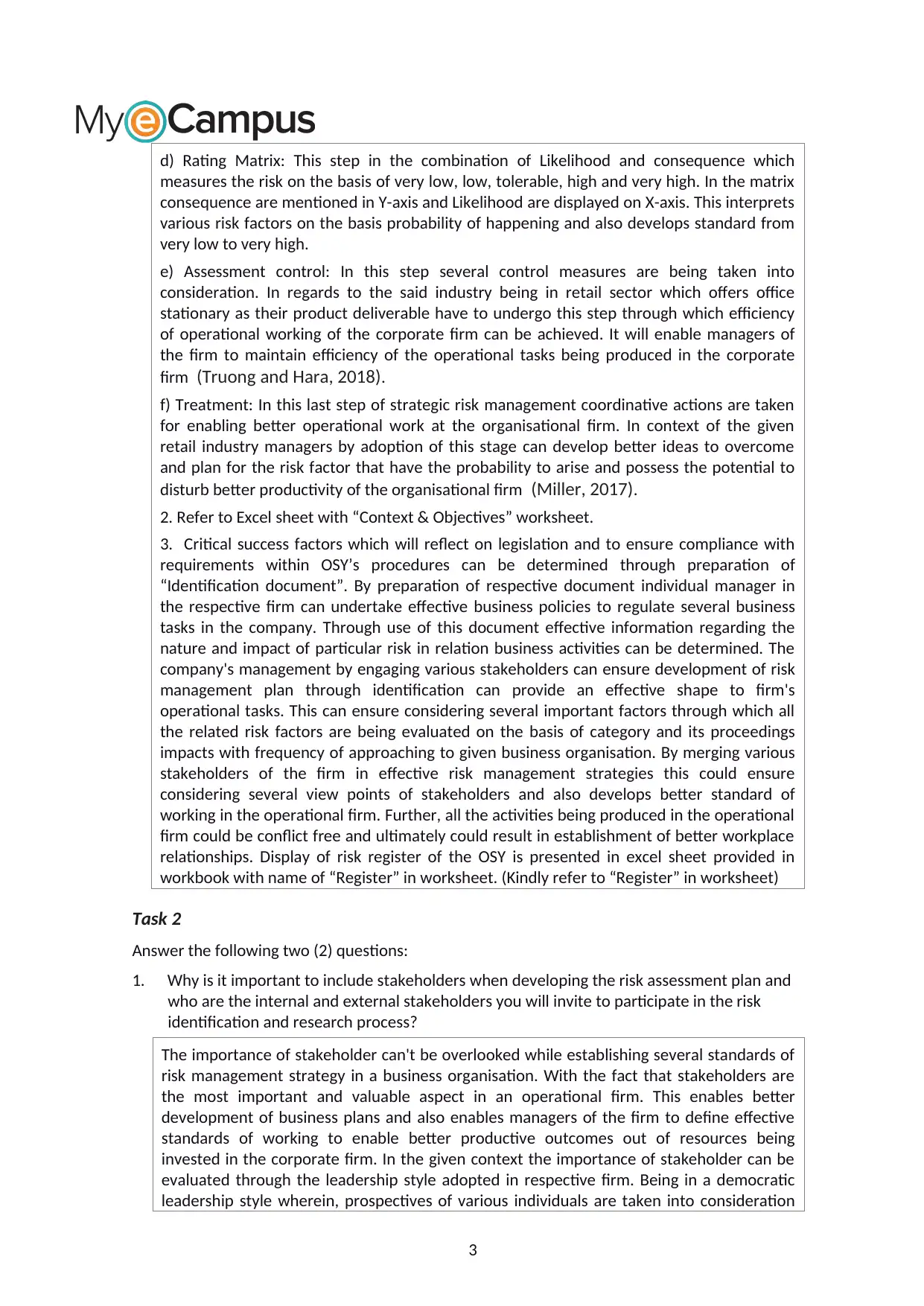
d) Rating Matrix: This step in the combination of Likelihood and consequence which
measures the risk on the basis of very low, low, tolerable, high and very high. In the matrix
consequence are mentioned in Y-axis and Likelihood are displayed on X-axis. This interprets
various risk factors on the basis probability of happening and also develops standard from
very low to very high.
e) Assessment control: In this step several control measures are being taken into
consideration. In regards to the said industry being in retail sector which offers office
stationary as their product deliverable have to undergo this step through which efficiency
of operational working of the corporate firm can be achieved. It will enable managers of
the firm to maintain efficiency of the operational tasks being produced in the corporate
firm (Truong and Hara, 2018).
f) Treatment: In this last step of strategic risk management coordinative actions are taken
for enabling better operational work at the organisational firm. In context of the given
retail industry managers by adoption of this stage can develop better ideas to overcome
and plan for the risk factor that have the probability to arise and possess the potential to
disturb better productivity of the organisational firm (Miller, 2017).
2. Refer to Excel sheet with “Context & Objectives” worksheet.
3. Critical success factors which will reflect on legislation and to ensure compliance with
requirements within OSY’s procedures can be determined through preparation of
“Identification document”. By preparation of respective document individual manager in
the respective firm can undertake effective business policies to regulate several business
tasks in the company. Through use of this document effective information regarding the
nature and impact of particular risk in relation business activities can be determined. The
company's management by engaging various stakeholders can ensure development of risk
management plan through identification can provide an effective shape to firm's
operational tasks. This can ensure considering several important factors through which all
the related risk factors are being evaluated on the basis of category and its proceedings
impacts with frequency of approaching to given business organisation. By merging various
stakeholders of the firm in effective risk management strategies this could ensure
considering several view points of stakeholders and also develops better standard of
working in the operational firm. Further, all the activities being produced in the operational
firm could be conflict free and ultimately could result in establishment of better workplace
relationships. Display of risk register of the OSY is presented in excel sheet provided in
workbook with name of “Register” in worksheet. (Kindly refer to “Register” in worksheet)
Task 2
Answer the following two (2) questions:
1. Why is it important to include stakeholders when developing the risk assessment plan and
who are the internal and external stakeholders you will invite to participate in the risk
identification and research process?
The importance of stakeholder can't be overlooked while establishing several standards of
risk management strategy in a business organisation. With the fact that stakeholders are
the most important and valuable aspect in an operational firm. This enables better
development of business plans and also enables managers of the firm to define effective
standards of working to enable better productive outcomes out of resources being
invested in the corporate firm. In the given context the importance of stakeholder can be
evaluated through the leadership style adopted in respective firm. Being in a democratic
leadership style wherein, prospectives of various individuals are taken into consideration
3
measures the risk on the basis of very low, low, tolerable, high and very high. In the matrix
consequence are mentioned in Y-axis and Likelihood are displayed on X-axis. This interprets
various risk factors on the basis probability of happening and also develops standard from
very low to very high.
e) Assessment control: In this step several control measures are being taken into
consideration. In regards to the said industry being in retail sector which offers office
stationary as their product deliverable have to undergo this step through which efficiency
of operational working of the corporate firm can be achieved. It will enable managers of
the firm to maintain efficiency of the operational tasks being produced in the corporate
firm (Truong and Hara, 2018).
f) Treatment: In this last step of strategic risk management coordinative actions are taken
for enabling better operational work at the organisational firm. In context of the given
retail industry managers by adoption of this stage can develop better ideas to overcome
and plan for the risk factor that have the probability to arise and possess the potential to
disturb better productivity of the organisational firm (Miller, 2017).
2. Refer to Excel sheet with “Context & Objectives” worksheet.
3. Critical success factors which will reflect on legislation and to ensure compliance with
requirements within OSY’s procedures can be determined through preparation of
“Identification document”. By preparation of respective document individual manager in
the respective firm can undertake effective business policies to regulate several business
tasks in the company. Through use of this document effective information regarding the
nature and impact of particular risk in relation business activities can be determined. The
company's management by engaging various stakeholders can ensure development of risk
management plan through identification can provide an effective shape to firm's
operational tasks. This can ensure considering several important factors through which all
the related risk factors are being evaluated on the basis of category and its proceedings
impacts with frequency of approaching to given business organisation. By merging various
stakeholders of the firm in effective risk management strategies this could ensure
considering several view points of stakeholders and also develops better standard of
working in the operational firm. Further, all the activities being produced in the operational
firm could be conflict free and ultimately could result in establishment of better workplace
relationships. Display of risk register of the OSY is presented in excel sheet provided in
workbook with name of “Register” in worksheet. (Kindly refer to “Register” in worksheet)
Task 2
Answer the following two (2) questions:
1. Why is it important to include stakeholders when developing the risk assessment plan and
who are the internal and external stakeholders you will invite to participate in the risk
identification and research process?
The importance of stakeholder can't be overlooked while establishing several standards of
risk management strategy in a business organisation. With the fact that stakeholders are
the most important and valuable aspect in an operational firm. This enables better
development of business plans and also enables managers of the firm to define effective
standards of working to enable better productive outcomes out of resources being
invested in the corporate firm. In the given context the importance of stakeholder can be
evaluated through the leadership style adopted in respective firm. Being in a democratic
leadership style wherein, prospectives of various individuals are taken into consideration
3
⊘ This is a preview!⊘
Do you want full access?
Subscribe today to unlock all pages.

Trusted by 1+ million students worldwide
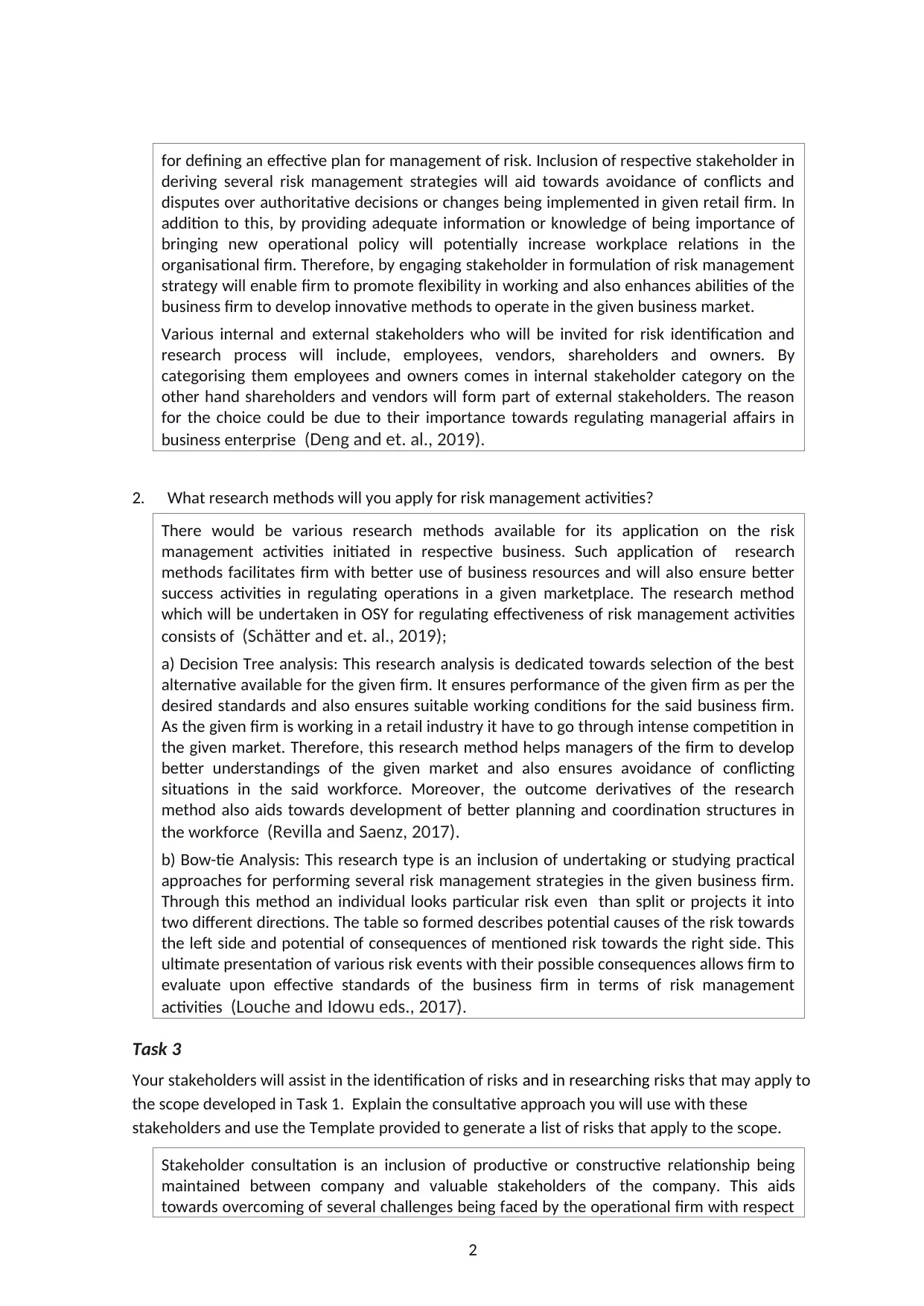
for defining an effective plan for management of risk. Inclusion of respective stakeholder in
deriving several risk management strategies will aid towards avoidance of conflicts and
disputes over authoritative decisions or changes being implemented in given retail firm. In
addition to this, by providing adequate information or knowledge of being importance of
bringing new operational policy will potentially increase workplace relations in the
organisational firm. Therefore, by engaging stakeholder in formulation of risk management
strategy will enable firm to promote flexibility in working and also enhances abilities of the
business firm to develop innovative methods to operate in the given business market.
Various internal and external stakeholders who will be invited for risk identification and
research process will include, employees, vendors, shareholders and owners. By
categorising them employees and owners comes in internal stakeholder category on the
other hand shareholders and vendors will form part of external stakeholders. The reason
for the choice could be due to their importance towards regulating managerial affairs in
business enterprise (Deng and et. al., 2019).
2. What research methods will you apply for risk management activities?
There would be various research methods available for its application on the risk
management activities initiated in respective business. Such application of research
methods facilitates firm with better use of business resources and will also ensure better
success activities in regulating operations in a given marketplace. The research method
which will be undertaken in OSY for regulating effectiveness of risk management activities
consists of (Schätter and et. al., 2019);
a) Decision Tree analysis: This research analysis is dedicated towards selection of the best
alternative available for the given firm. It ensures performance of the given firm as per the
desired standards and also ensures suitable working conditions for the said business firm.
As the given firm is working in a retail industry it have to go through intense competition in
the given market. Therefore, this research method helps managers of the firm to develop
better understandings of the given market and also ensures avoidance of conflicting
situations in the said workforce. Moreover, the outcome derivatives of the research
method also aids towards development of better planning and coordination structures in
the workforce (Revilla and Saenz, 2017).
b) Bow-tie Analysis: This research type is an inclusion of undertaking or studying practical
approaches for performing several risk management strategies in the given business firm.
Through this method an individual looks particular risk even than split or projects it into
two different directions. The table so formed describes potential causes of the risk towards
the left side and potential of consequences of mentioned risk towards the right side. This
ultimate presentation of various risk events with their possible consequences allows firm to
evaluate upon effective standards of the business firm in terms of risk management
activities (Louche and Idowu eds., 2017).
Task 3
Your stakeholders will assist in the identification of risks and in researching risks that may apply to
the scope developed in Task 1. Explain the consultative approach you will use with these
stakeholders and use the Template provided to generate a list of risks that apply to the scope.
Stakeholder consultation is an inclusion of productive or constructive relationship being
maintained between company and valuable stakeholders of the company. This aids
towards overcoming of several challenges being faced by the operational firm with respect
2
deriving several risk management strategies will aid towards avoidance of conflicts and
disputes over authoritative decisions or changes being implemented in given retail firm. In
addition to this, by providing adequate information or knowledge of being importance of
bringing new operational policy will potentially increase workplace relations in the
organisational firm. Therefore, by engaging stakeholder in formulation of risk management
strategy will enable firm to promote flexibility in working and also enhances abilities of the
business firm to develop innovative methods to operate in the given business market.
Various internal and external stakeholders who will be invited for risk identification and
research process will include, employees, vendors, shareholders and owners. By
categorising them employees and owners comes in internal stakeholder category on the
other hand shareholders and vendors will form part of external stakeholders. The reason
for the choice could be due to their importance towards regulating managerial affairs in
business enterprise (Deng and et. al., 2019).
2. What research methods will you apply for risk management activities?
There would be various research methods available for its application on the risk
management activities initiated in respective business. Such application of research
methods facilitates firm with better use of business resources and will also ensure better
success activities in regulating operations in a given marketplace. The research method
which will be undertaken in OSY for regulating effectiveness of risk management activities
consists of (Schätter and et. al., 2019);
a) Decision Tree analysis: This research analysis is dedicated towards selection of the best
alternative available for the given firm. It ensures performance of the given firm as per the
desired standards and also ensures suitable working conditions for the said business firm.
As the given firm is working in a retail industry it have to go through intense competition in
the given market. Therefore, this research method helps managers of the firm to develop
better understandings of the given market and also ensures avoidance of conflicting
situations in the said workforce. Moreover, the outcome derivatives of the research
method also aids towards development of better planning and coordination structures in
the workforce (Revilla and Saenz, 2017).
b) Bow-tie Analysis: This research type is an inclusion of undertaking or studying practical
approaches for performing several risk management strategies in the given business firm.
Through this method an individual looks particular risk even than split or projects it into
two different directions. The table so formed describes potential causes of the risk towards
the left side and potential of consequences of mentioned risk towards the right side. This
ultimate presentation of various risk events with their possible consequences allows firm to
evaluate upon effective standards of the business firm in terms of risk management
activities (Louche and Idowu eds., 2017).
Task 3
Your stakeholders will assist in the identification of risks and in researching risks that may apply to
the scope developed in Task 1. Explain the consultative approach you will use with these
stakeholders and use the Template provided to generate a list of risks that apply to the scope.
Stakeholder consultation is an inclusion of productive or constructive relationship being
maintained between company and valuable stakeholders of the company. This aids
towards overcoming of several challenges being faced by the operational firm with respect
2
Paraphrase This Document
Need a fresh take? Get an instant paraphrase of this document with our AI Paraphraser
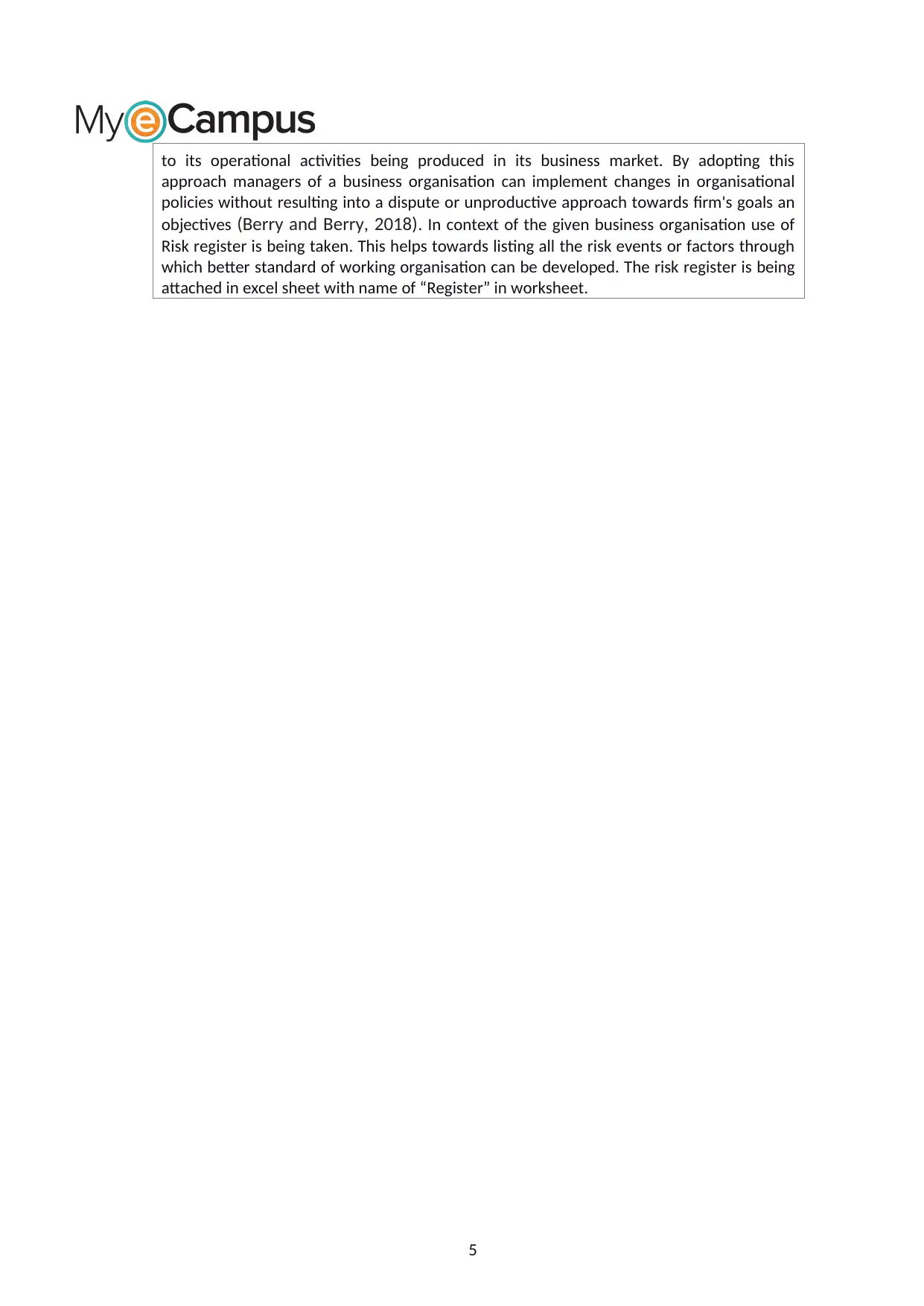
to its operational activities being produced in its business market. By adopting this
approach managers of a business organisation can implement changes in organisational
policies without resulting into a dispute or unproductive approach towards firm's goals an
objectives (Berry and Berry, 2018). In context of the given business organisation use of
Risk register is being taken. This helps towards listing all the risk events or factors through
which better standard of working organisation can be developed. The risk register is being
attached in excel sheet with name of “Register” in worksheet.
5
approach managers of a business organisation can implement changes in organisational
policies without resulting into a dispute or unproductive approach towards firm's goals an
objectives (Berry and Berry, 2018). In context of the given business organisation use of
Risk register is being taken. This helps towards listing all the risk events or factors through
which better standard of working organisation can be developed. The risk register is being
attached in excel sheet with name of “Register” in worksheet.
5
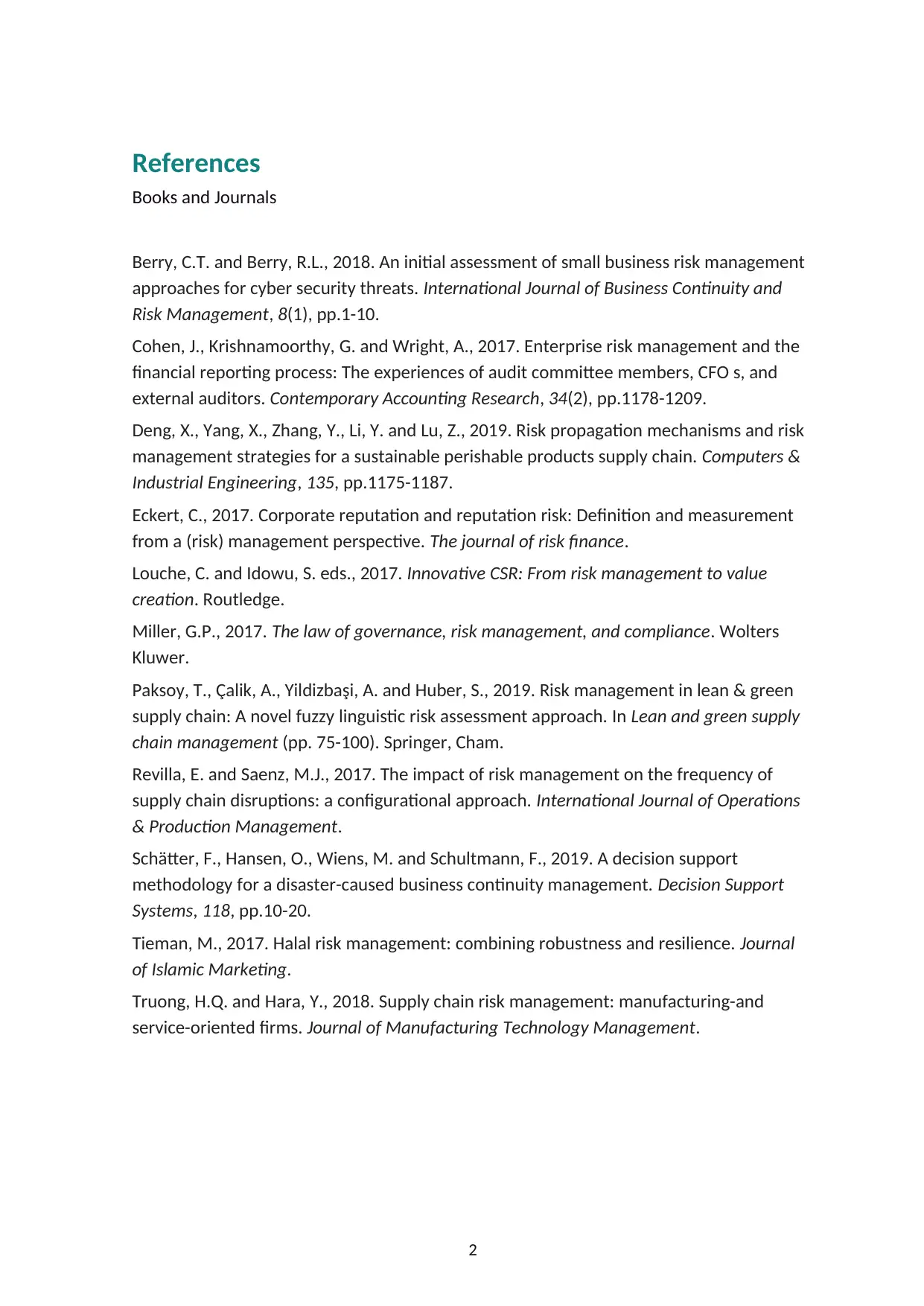
References
Books and Journals
Berry, C.T. and Berry, R.L., 2018. An initial assessment of small business risk management
approaches for cyber security threats. International Journal of Business Continuity and
Risk Management, 8(1), pp.1-10.
Cohen, J., Krishnamoorthy, G. and Wright, A., 2017. Enterprise risk management and the
financial reporting process: The experiences of audit committee members, CFO s, and
external auditors. Contemporary Accounting Research, 34(2), pp.1178-1209.
Deng, X., Yang, X., Zhang, Y., Li, Y. and Lu, Z., 2019. Risk propagation mechanisms and risk
management strategies for a sustainable perishable products supply chain. Computers &
Industrial Engineering, 135, pp.1175-1187.
Eckert, C., 2017. Corporate reputation and reputation risk: Definition and measurement
from a (risk) management perspective. The journal of risk finance.
Louche, C. and Idowu, S. eds., 2017. Innovative CSR: From risk management to value
creation. Routledge.
Miller, G.P., 2017. The law of governance, risk management, and compliance. Wolters
Kluwer.
Paksoy, T., Çalik, A., Yildizbaşi, A. and Huber, S., 2019. Risk management in lean & green
supply chain: A novel fuzzy linguistic risk assessment approach. In Lean and green supply
chain management (pp. 75-100). Springer, Cham.
Revilla, E. and Saenz, M.J., 2017. The impact of risk management on the frequency of
supply chain disruptions: a configurational approach. International Journal of Operations
& Production Management.
Schätter, F., Hansen, O., Wiens, M. and Schultmann, F., 2019. A decision support
methodology for a disaster-caused business continuity management. Decision Support
Systems, 118, pp.10-20.
Tieman, M., 2017. Halal risk management: combining robustness and resilience. Journal
of Islamic Marketing.
Truong, H.Q. and Hara, Y., 2018. Supply chain risk management: manufacturing-and
service-oriented firms. Journal of Manufacturing Technology Management.
2
Books and Journals
Berry, C.T. and Berry, R.L., 2018. An initial assessment of small business risk management
approaches for cyber security threats. International Journal of Business Continuity and
Risk Management, 8(1), pp.1-10.
Cohen, J., Krishnamoorthy, G. and Wright, A., 2017. Enterprise risk management and the
financial reporting process: The experiences of audit committee members, CFO s, and
external auditors. Contemporary Accounting Research, 34(2), pp.1178-1209.
Deng, X., Yang, X., Zhang, Y., Li, Y. and Lu, Z., 2019. Risk propagation mechanisms and risk
management strategies for a sustainable perishable products supply chain. Computers &
Industrial Engineering, 135, pp.1175-1187.
Eckert, C., 2017. Corporate reputation and reputation risk: Definition and measurement
from a (risk) management perspective. The journal of risk finance.
Louche, C. and Idowu, S. eds., 2017. Innovative CSR: From risk management to value
creation. Routledge.
Miller, G.P., 2017. The law of governance, risk management, and compliance. Wolters
Kluwer.
Paksoy, T., Çalik, A., Yildizbaşi, A. and Huber, S., 2019. Risk management in lean & green
supply chain: A novel fuzzy linguistic risk assessment approach. In Lean and green supply
chain management (pp. 75-100). Springer, Cham.
Revilla, E. and Saenz, M.J., 2017. The impact of risk management on the frequency of
supply chain disruptions: a configurational approach. International Journal of Operations
& Production Management.
Schätter, F., Hansen, O., Wiens, M. and Schultmann, F., 2019. A decision support
methodology for a disaster-caused business continuity management. Decision Support
Systems, 118, pp.10-20.
Tieman, M., 2017. Halal risk management: combining robustness and resilience. Journal
of Islamic Marketing.
Truong, H.Q. and Hara, Y., 2018. Supply chain risk management: manufacturing-and
service-oriented firms. Journal of Manufacturing Technology Management.
2
⊘ This is a preview!⊘
Do you want full access?
Subscribe today to unlock all pages.

Trusted by 1+ million students worldwide
1 out of 6
Your All-in-One AI-Powered Toolkit for Academic Success.
+13062052269
info@desklib.com
Available 24*7 on WhatsApp / Email
![[object Object]](/_next/static/media/star-bottom.7253800d.svg)
Unlock your academic potential
Copyright © 2020–2025 A2Z Services. All Rights Reserved. Developed and managed by ZUCOL.


